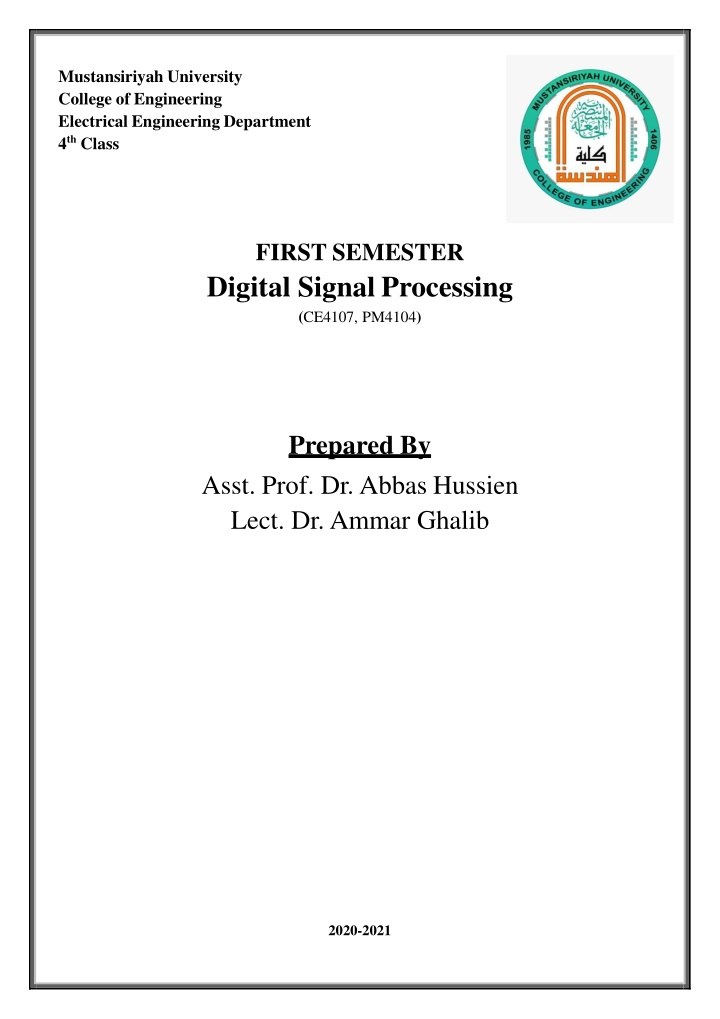
Digital Signal Processing in Electrical Engineering Department at Mustansiriyah University
Explore the 4th Class First Semester course on Digital Signal Processing at Mustansiriyah University's College of Engineering. Topics covered include signal sampling, digital systems, convolution, frequency response, Z-transform, and more. Dive into the world of digital signals and systems with Dr. Abbas Hussien and Dr. Ammar Ghalib as your guides.
Download Presentation

Please find below an Image/Link to download the presentation.
The content on the website is provided AS IS for your information and personal use only. It may not be sold, licensed, or shared on other websites without obtaining consent from the author. If you encounter any issues during the download, it is possible that the publisher has removed the file from their server.
You are allowed to download the files provided on this website for personal or commercial use, subject to the condition that they are used lawfully. All files are the property of their respective owners.
The content on the website is provided AS IS for your information and personal use only. It may not be sold, licensed, or shared on other websites without obtaining consent from the author.
E N D
Presentation Transcript
Mustansiriyah University College of Engineering Electrical Engineering Department 4thClass FIRST SEMESTER Digital Signal Processing (CE4107, PM4104) Prepared By Asst. Prof. Dr. Abbas Hussien Lect. Dr. Ammar Ghalib 2020-2021
Digital Signal Processing/ 4th Class/ 2020-2021 Dr. Abbas Hussien & Dr. Ammar Ghalib Topics Covered Introduction to Digital Signal Processing Signal Sampling and Reconstructions: Sampling of Continuous Signal, Signal Reconstruction, Aliasing Noise Level Digital Signals and Systems: Classification of Systems, Linear System, Time-Invariant System, Causal System, Stability Digital Convolution: Graphical Method, Table Lookup Method, Matrix by Vector Method, Linear Convolution and Circular Convolution, Deconvolution Frequency Response and Sinusoidal Steady State Response Z-Transform (Review), Discrete Fourier Transform, Fast Fourier Transform Theoretical: 2 Hrs/Wk Tutorial: 1 Hr/Wk Total hours per semester (30 Theoretical + 15 Tutorial) Suggested References: 1) "Digital Signal Processing Principles, Algorithms, and Applications", John G. Proakis, Dimitris G. Manolakis, Third Edition (1996). 2) "Applied Digital Signal Processing Theory and Practice", Dimitris G. Manolakis, Vinay K. Ingle, First Edition (2011).
Digital Signal Processing/ 4th Class/ 2020-2021 Dr. Abbas Hussien & Dr. Ammar Ghalib Introduction to Digital Signal Processing Signal (flow of information): Signal is defined as any physical quantity that varies with Time, Space, or any other independent variables. For Example: Measured quantity that varies with time (or position). Electrical signal received from a transducer (Microphone, Thermometer, Accelerometer, Antenna, etc.) Electrical signal that controls a process. Example: A. Continuous-Time Signal or AnalogSignal: The analog signal is defined for every value of time and they take on values in the continuous interval as shown in Fig. 1. Fig. 1. Continuous or analog signal Continuous in time. Amplitude may take on any value in the continuous range of(- , ). Analog Processing Differentiation, Integration, Filtering, Amplification. Differential Equations Implemented via passive or active electronic circuitry. B. Discrete-Timesignals: Discrete signals are defined only at certain specific value of time as shown in Fig. 2. . Fig. 2. Discrete signal 1
Digital Signal Processing/ 4th Class/ 2020-2021 Dr. Abbas Hussien & Dr. Ammar Ghalib Continuous in amplitude but discrete in time. Only defined for certain time instances. Can be obtained from analog signals via sampling. C. DigitalSignal: Digital signal is the signal that takes on values from a finite set of possible values as shown in Fig. 3. Fig. 3. Digital signal with four different amplitude values Discrete in amplitude & discrete in time. Can be obtained from discrete signals via quantization. Finite and infinite lengthsignal: Finite length signal is nonzero over a finite interval tmin< t< tmax as shown in Fig. 4. Fig. 4. Finite length signal In contrast, the infinite length signal is nonzero over all real numbers. What is signal processing? Signals may have to be transformed in order to Amplify or filter out embedded information. Detect patterns. Prepare the signal to survive a transmission channel. Undo distortions contributed by a transmission channel. Compensate for sensor deficiencies. Find information encoded in a different domain. 2








